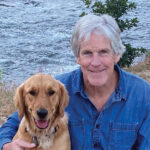What Is the Human Potential Movement?
Getty/oatawa
The Human Potential Movement peaked in the 1960s and 1970s. Read about it from someone who was there.
The Human Potential Movement was given shape and purpose by the Brooklyn-born psychologist Abraham Maslow, who created perhaps the best-known modern pyramid. Called the Hierarchy of Needs, the pyramid maps the journey from survival needs like food and shelter to what Maslow called self-actualization. Unlike ancient pyramids, the Hierarchy of Needs is not a symbol of wealth, power, authority, or immortality. Instead, it’s a seven-step path toward individual fulfillment that’s open to everyone.
Circumstances of birth mean that people don’t start at the same step or have the same opportunities to climb, but the point of the pyramid is ultimately the same. Wrote Maslow, “A musician must make music, an artist must paint, a poet must write, if he is to be ultimately at peace with himself.” The perils along the path are ultimately the same as well: the limitations of our own perception. Wrote Maslow, “If the only tool you have is a hammer, you tend to see every problem as a nail.”
Maslow began publishing his ideas during World War II, and it was America’s victory that ultimately turned the father of humanistic psychology into the figurehead of the popular Human Potential Movement. One of Maslow’s friends, T George Harris, epitomized the personal transformation. T George grew up on a small Kentucky tobacco farm working behind a mule-driven plow. The self-described “runt of the litter,” he survived both rickets and polio and planned to become a preacher, but enlisted instead to fight in the Army. After landing at Omaha Beach, he became a forward artillery scout. At a Holocaust camp at Ordruff, he witnessed the worst that human beings can do to each other and came back to America determined to find the best. Empowered by the GI Bill, T George studied sociology at Yale and became a reporter for Time, where he covered the front lines of the Civil Rights movement as well as the work of Maslow. In 1967, T George became editor in chief of Psychology Today, the mouthpiece of the Human Potential movement. (30 years later, T George would launch Spirituality & Health.)
Human Potential Movement Origins
The Human Potential Movement was famously conceived in hot tubs overlooking the Pacific Ocean near Big Sur, California.
The natural hot springs had been sacred to the Esselen Indians, and the land was owned by the family of a Stanford graduate named Michael Murphy, who was curious to learn the full capabilities of the human mind and body. In 1962, Murphy and his friend Dick Price made the tubs the focal point of the Esalen Institute. Maslow soaked there, along with almost every other important humanistic psychologist. With them were thought leaders like Aldous Huxley, who opened the doors of perception with various drugs; George Leonard, a journalist who coined the term human potential and spread the gospel of martial arts; Gabrielle Roth, a dancer who systemized a way of getting high using music in five rhythms; and Jean Houston, a creativity guru who encouraged people to writhe on the ground like newts.
The Human Potential Movement arrived at a heady time. The first rockets had been fired into space and God wasn’t there (and would soon be declared dead on the cover of Time). Old authorities and shackles of all kinds were being cast off. Equality was rising and new technologies were bringing people together in ways never before experienced. One of the most disruptive new technologies was the pill. While Paris of the ’20s drew bohemian spirits with legal booze during America’s Prohibition (and every page of Hemingway practically drips with wine), Esalen offered nude massage and the opportunity to play like bonobos. A typical example was my father, who conceived the first of his four children on his wedding night, went to Esalen, and then quit the aerospace industry to help launch Zero Population Growth (Stop at 2!). Among its many contributions, The Human Potential Movement added divorce as a rite of passage toward higher consciousness.
One core belief of the Human Potential Movement is that higher consciousness is good. Maslow’s Religion, Values and Peak Experience, published in 1964, helped set the stage. Maslow argued that each of us has the potential for transcendent experiences and that such experiences are self-validating. In other words, they don’t require religion. Thus, for the Human Potential Movement, the very tip of Maslow’s pyramid became a Christ consciousness or Buddha consciousness that anyone could aspire to and perhaps achieve by following his or her own path. On a larger scale, it was argued that as more people were born higher on Maslow’s pyramid, the world would become more peaceful and more equal.
One of the great awakenings of the Human Potential Movement was to recognize the mind’s ability to control the body, and a major pioneer was Harvard cardiologist Herbert Benson, MD. In the sixties, Dr. Benson began studying TM meditators and Tibetan monks and proved that meditation (the “Relaxation Response”) could dramatically change not just brain waves, but blood pressure, heart rate, and skin temperature. Such work demonstrated that meditation of all kinds could be profoundly healing and helped launch the field of mind-body medicine.
One goal of the Human Potential Movement was to understand and expand creativity, intuition, Extra Sensory Perception (ESP or psi), and consciousness itself. Many argued that consciousness is transpersonal, a field outside of the brain that exists beyond time and space in which, for example, a thousand people meditating together could help make the entire field more peaceful. Some of the key research happened at Stanford Research Institute (SRI), led by a laser physicist named Russell Targ, who was a close family friend. So, when Russell built an ESP training machine, we had one in our living room. The machine had four pictures on the front that would light up randomly, one at a time, and the purpose of the machine was to see if people could learn to predict which picture would light up next—to discover if ESP got better with practice. As a teenager, I was confident my own ESP would get better, but it didn’t. Then the machines disappeared because no one did better than chance. More intriguing were SRI’s studies of remote viewing, in which one clears the mind and attempts to describe or draw an unseen object or a remote place. Ironically, this peak of Human Potential research in the late 1970s was funded by the CIA in an attempt to spy on Soviet missile bases.
The Human Potential Movement Today
Before his death in 2013, T George Harris said the Human Potential movement began to wane in 1982, when Forbes magazine created the Forbes 400, a ranking of the world’s richest people. That’s when America’s North Star shifted back toward greed—which was declared good—and inequality began to rise again.
In the ’90s, the “decade of the brain,” psychology was overshadowed by neuroscience, which is now being overshadowed by artificial intelligence. The once grand question of whether a computer can become conscious or not may soon become academic as AI leapfrogs beyond it.
And yet T George remained profoundly optimistic. He pointed out that people are living longer, healthier lives with instant access to infinitely more information as well as the freedom to explore forms of self-actualization never before dreamed of. While psychologists have shown that more and more choices make personal satisfaction more and more elusive, self-actualization remains a noble goal, even if the peak is as elusive as ever. We humans have not yet reached our potential.


